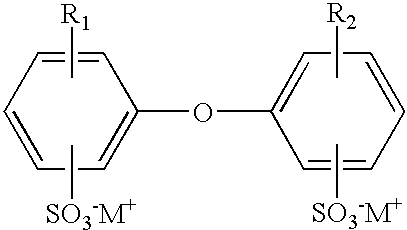Latex processes
a technology of latex and process, applied in the field of latex processes, can solve the problems of poor toner flow, high dielectric loss, adversely affecting the functional properties or processing of the final toner,
- Summary
- Abstract
- Description
- Claims
- Application Information
AI Technical Summary
Benefits of technology
Problems solved by technology
Method used
Image
Examples
examples ia
and IB represent examples with and without chain-transfer agent partitioning.
examples iia and iib
represent examples with varying ratios of chain-transfer agent partitioning in the monomer emulsion.
example ia
A non-ionic surfactant free latex was prepared by the semi-continuous emulsion polymerization of styrene / n-butyl acrylate / 2-carboxyethyl acrylate (.beta.-CEA) copolymer, 75 / 24 / 3 parts (by weight), using 1.50 pph of 1-dodecanethiol (DDT; the first monomer emulsion portion contained 0.5 pph and the second monomer emulsion portion contained 2.097 pph) as a chain-transfer agent, 0.35 pph of decanediol diacrylate (A-DOD) as a cross-linking agent and 1.5 percent by weight (based on monomer content) of ammonium persulfate as an initiator. A 2 Liter jacketed stainless steel reactor, with double flight impellers, containing 2.61 grams of DOWFAX 2A1.TM. (sodium tetrapropyl diphenyloxide disulfonate, 47 percent active, available from Dow Chemical) and 583.7 grams of deionized water was stirred at 200 rpm while the temperature was about 75.degree. C. In a 2 Liter container, a monomer emulsion was prepared by vigorously mixing a monomer mixture (466.64 grams of styrene, 147.36 grams of n-butyl a...
PUM
| Property | Measurement | Unit |
|---|---|---|
| temperature | aaaaa | aaaaa |
| temperature | aaaaa | aaaaa |
| thickness | aaaaa | aaaaa |
Abstract
Description
Claims
Application Information
 Login to View More
Login to View More - R&D
- Intellectual Property
- Life Sciences
- Materials
- Tech Scout
- Unparalleled Data Quality
- Higher Quality Content
- 60% Fewer Hallucinations
Browse by: Latest US Patents, China's latest patents, Technical Efficacy Thesaurus, Application Domain, Technology Topic, Popular Technical Reports.
© 2025 PatSnap. All rights reserved.Legal|Privacy policy|Modern Slavery Act Transparency Statement|Sitemap|About US| Contact US: help@patsnap.com



